Living Planet
Nature · Earth · ClimateNature Notes: July 2020
MEADOWLANDS ...
'The farmers grind and whet their scythes, While hay-stacks in the meadows rise:
Green fields and shady groves appear, And rip'ning harvest crowns the year.' 1793 Farmer's Almanac
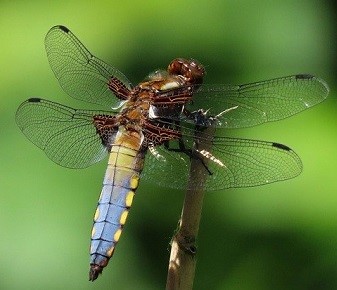
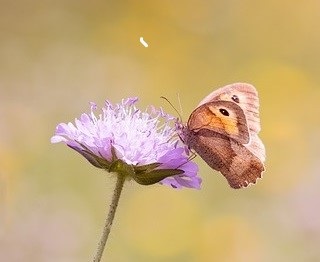
Anglo Saxons called July 'Mead-month' from the meadows displaying in full bloom. Whilst unfortunately we no longer have much ancient meadowland around Slinfold (meadows in the UK have declined over 97% since World War 2 ), with the early spring sunshine the hypnotising song of long grasses in the breeze, dotted with the colourful sight of splashes of wild flowers at varying heights, was well under way, in the meadowland we do have, by May. Some had already been cut for haylage and was re-grown by June. The high-pitched squeaky bleat from some swaying fronds belied the camouflaged presence of a fawn that warily followed my path as I pretended not to notice and wended my way ahead. Where these grasslands bordered the Arun tributaries some spectacular dragonflies zig-zagged - the broad, flattened bodies of the male Broad-bodied Chaser in powder-blue with yellow spots along the sides, seem to be having a good year as do male Meadow Brown butterflies, large numbers of which I saw flying low over the grass and flowers. Nearby, a smaller and more orange Gatekeeper, fanned it's sunset wings on some couch grass and along the hedgerow, the characteristic bobbing dip of the dark, chocolate velvet Ringlet, wings dotted with cream circles and tinged with white, came to alight on the delicate pink of a bramble flower.
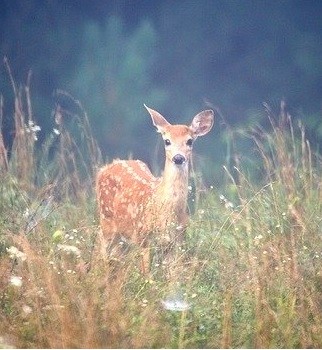
If only shrews could fly to pastures new! The very dry and rock-hard ground of late May and June not only saw me sustain a broken bone but was disastrous for the numerous shrews whose dead bodies with bloodied noses, lay, sadly on footpaths all around the field margins - suggesting the solid surface had been blocking their foraging attempts. If they don't eat within a few hours they die. And I saw also saw newly emerged toadlets which had dried up, not far away from their birthing pond, presumably before they found moist soil and shade.
Dry ground and hot weather can often also alter insect feeding by increasing leaf toughness and having been forcibly confined to my garden, I noticed other creatures behaving differently. The Song Thrush seemed to know the snails had retreated to the cool, moist spout of the watering can as it pecked on the outside and two broods of fledgling tits gathered on the feeder to eat as well as drink.. A mother pheasant brought 9 chicks in under the garden gate, to dust-bathe and snooze in a recently watered flower bed, a robin repeatedly flicked his wings in and around the bird-bath and an itching squirrel tried to drown his fleas. The fairy-sized 'wild strawberries' around my perimeter have been providing much needed 'juice' for field voles, and I'm hoping that any baby hoglets, foraging in July for the first time with their mums, may also discover their delights. Hopefully the supply will last long until the first blackberries appear at the end of the month. A pile of native Horsham stone rocks, dug out of my drive and beds, have lent themselves perfectly to a lizard lounger - one lazing on the top during the sunshine and then cooling/hiding in the shade provided by the cracks in between.
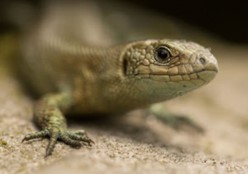
The delightful sound of a returning nightingale has been leading my glances upwards, beyond the bushes, the shady trees and to the clouds up - an ever-changing landscape of shapes and colours, light and shade, movement and possibilities. Swifts, swallows and house martins, have been darting across my field of vision and back again - the latter finding it hard to build nests as they've been no puddles from which they could 'make mud'. A balloon burst of notes revealed a skylark rising almost vertically with rapid wing-beats, which hovered, suspended in the blue before parachuting down out of sight. I'm hoping soon to see Sirius, the Dog-star, after which the 'Dog Days of Summer' (traditionally between 3rd July - 11th August) get their name - it's the brightest start in the sky apart from the sun. At night, I'm looking forward to the full moon on the 5th which is either known as the Thunder Moon (because of thunderstorms) or the Buck Moon, as a buck's antlers are at their peak growing stage during this time.
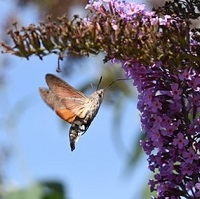
Whilst moth numbers tend to reach their peak at night in July, they're generally less active during a full moon, as many think it's still day, but I'm looking forward to the return one particular species that flies in bright sunshine as well as dusk, dawn and in the rain. The Hummingbird Hawkmoth, which is partial to my garden Buddleia also frequents woodland edges and hayfields full of flowers. Long considered a good omen (a small swarm was famously seen flying over the Channel on D-Day in 1944) to me they epitomise summer, sunshine and meadows. They appear, as if by magic and then buzz, hover and fly with wing beats up to an incredible 80 times a second, before reaching into each flower with their long proboscis before returning to the same, high pollen delights every day at about the same time. I hope the Hummingbird moth's graceful, dancing-like appearance on each flower, and its recollection of the good things in life, help us all to continually find the joy of nature in July and to stretch our wings and dance in meadows whenever and wherever we can!